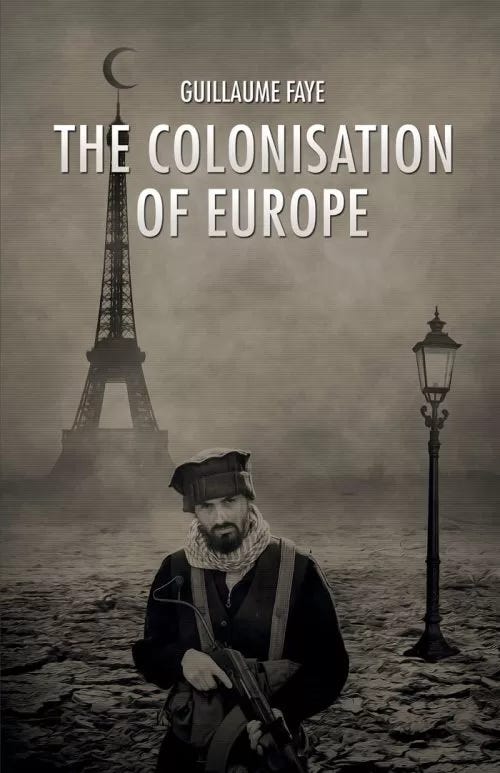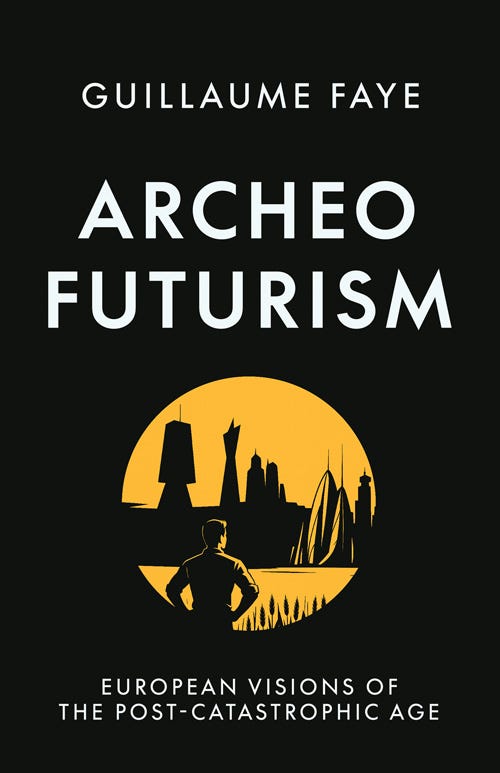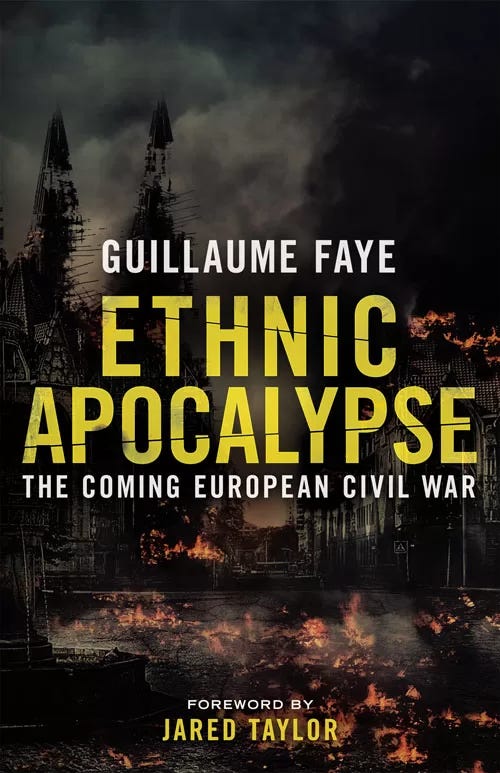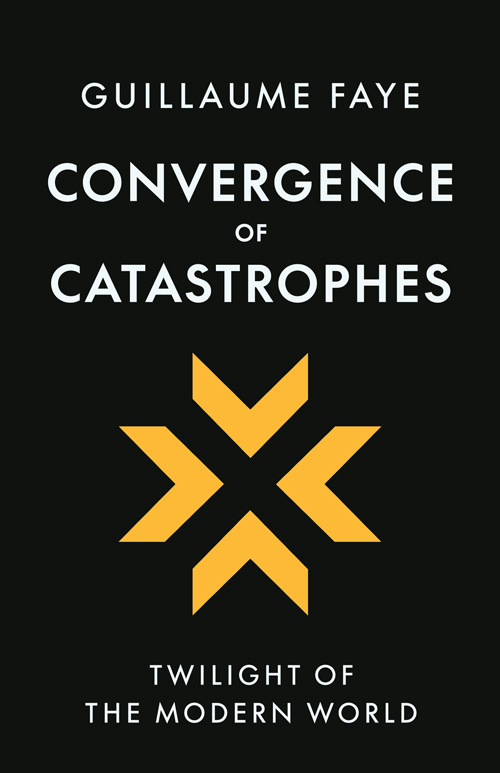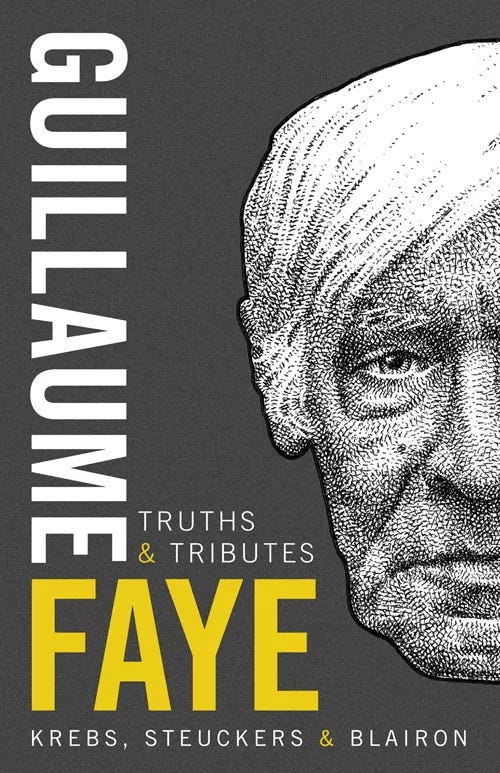Guillaume Faye: Awakener of the Twenty-First Century
by Pierre-Émile Blairon
Pierre-Émile Blairon commemorates the works and legacy of Guillaume Faye as a visionary, frontline awakener, comparing Faye’s life to a meteor: a radiant cosmic rock flying through the heavens which serves as an omen and burns up before ever falling.
Guillaume Faye was an awakener. Awakeners are men who come from an immanent, immutable and permanent world, that ‘other world’ that lies parallel to ours, arriving here to accomplish a mission. These men have no other concern than to pass on their knowledge and energy; and their entire life ends up being devoted to this transmission. Awakeners appear in critical periods of history, when everything has been turned upside down and all values reversed, and when the situation seems desperate. They give their mission priority over their own person, their personal interest and their comfort. Their rule of thumb is the following one: do what you must, without anticipating success. The La Rochefoucault family had turned this principle into their motto: ‘Do what must be done, come what may’…
A Multifaceted Talent
Guillaume Faye’s genius was expressed in different ways and at different times. The very structure of his thoughts was, however, a homogeneous one. Whatever some may have thought, he never contradicted himself.
Based on the strategic choices he made throughout his life and the ideas he always hammered home in his work, one can notice an evolution that took place from top to bottom, i.e. from ideological concepts to the reality on the ground. Guillaume Faye was a field activist: the sole purpose of his work is, ultimately, to suggest emergency solutions and define the necessary methods that would enable their realistic and effective implementation. Guillaume declared himself a follower of Aristotle, the philosopher for whom everything was subject to demonstration.
Guillaume dedicated himself to many (often very different) activities and excelled in every single one.
He was, above all else, a brilliant and passionate orator: his often-improvised speech was marked by flashes of sheer brilliance, which he himself discovered at the very same moment the public did and which aroused awe within him as well. Most speakers need to follow a set pattern, which is definitely my case, as I cannot speak without having any notes at my disposal; otherwise, I forget half of what I have promised myself to say. By contrast, a piece of paper was always enough for Guillaume, and it must be said that I never saw him begin a lecture without a good helping of his favourite fuel, i.e. beer or wine.
During a period that lasted for ten whole years, from 1987 to 1997, Guillaume worked as a radio host going by the name of Skyman, as well as a television host on France 2, where he came up with various pranks in the programme Télématin. During that same period, he also participated in comic book magazines such as L’Écho des savanes, in the company of more or less insane authors, who, more often than not, belonged to the extreme-left spectrum.
He would resume his activism as a lecturer, a journalist and a writer upon returning to G.R.E.C.E. in 1997, following a ten-year separation from the latter. Regarding his literary activity, apart from his truly numerous articles published in the movement’s various magazines, he authored twenty-eight books in three different periods, the first lasting from 1981 to 1987. The second took place outside the metapolitical sphere and stretched from 1987 to 1997. As for the third, it began in 1998 and lasted until his death. In 2000, he would, once again, be excluded from G.R.E.C.E., as a result of the publication of his book entitled La colonisation de l’Europe [The Colonisation of Europe], which was allegedly deemed too politically incorrect by G.R.E.C.E leaders.
There is a chronological logic to be found in the development of his literary production. Indeed, the first period corresponds to the elaboration of a doctrinal corpus through his first book, Le système à tuer les peoples (published in 1981), and a very interesting booklet entitled L’Occident comme déclin, which was released in 1984. As for the second period, it is of less interest, unless one is a comic book enthusiast.
The third period would see Faye come out all guns blazing with Archéofuturisme [Archeofuturism] and the first pamphlets targeting Islam, including La colonisation de l’Europe, originally published in 2000.
In his last book, La guerre civile raciale, these pamphlets would become an entire indictment against the invasion of Europe at the hands of the Muslim masses arriving from the Maghreb and sub-Saharan/black Africa.
Guillaume’s mind would follow the development of this situation most closely and he would react like a general on a battlefield, a general who had mastered all the factors, minute by minute, and had made decisions which most of his subordinates were unable to understand. His readers and friends were often taken aback by what they believed to be sudden about-turns, which they were not, however. Guillaume Faye always waged attacks in the exact places where defences had weakened and where they needed to be reinforced. Little by little, and with the precision of a ‘surgical strike’, he pinpointed the gravest danger, pushing aside the remaining ones and advocating temporary alliances, especially with Israel, which was not to everyone’s liking. He thus highlighted the danger to which one had to turn all of their attention and efforts, namely the Great Replacement of the European populations at the hands of African populations that were being manipulated and united by the Muslim religion. In his last book, which was published posthumously, Guillaume no longer makes any distinction between Islam and Islamism, and thus uses the generic term ‘Muslim’ instead. I bought his last book from Daniel Conversano, who, having been Guillaume’s final publisher, took it out of the trunk of his car, inside the perimeter of the cemetery where Guillaume had been interred. This was yet another way to pay homage to him.
The Main Themes in Guillaume Faye’s Works
One can extract several main themes from the work of Guillaume Faye, themes which he bore within him throughout his life and repeated in almost every single book and speech. It is a permanent feature or constant that is found in all artists and authors that have a message to convey: they thus hammer it home so that it becomes well-imprinted in people’s minds and permeates their eyes and ears. As for us, we have adopted most of these topics, which thus embody the very essence of our struggles and conversations.
The fight against standardisation and globalism — In the 1970s, it was mainly the United States that imposed upon us its commercial dictates and its society of endless disposability. The reign of quantity had spread across the entire planet.
The Left-Right divide that still existed at the turn of the previous century is no longer appropriate, for we have realised that the struggle actually involves two opposing extremes: the globalists on one side and the identitarians on the other; our world’s standardisation versus the preservation of our territories; nature versus the artificial; and localism versus the ‘zonification’ of spaces.
Europe — In Guillaume Faye’s eyes, Europe is not merely the power that has shaped the world through its creativity and technological ingenuity. Indeed, thanks to the very diversity of its own peoples, it also acts as the last flag-bearer of the white world. The first thing one had to do was to clearly distinguish the western world, which would become that of a Big Brother paving the way for a global government, from the world of tradition, which dates back thousands of years and retains the roots without which nothing can grow. And it was Faye who, more than anyone else, drew the line that separates the two. Our Europe is not that of Brussels, which only relays the above-mentioned globalism, but the true Europe of blood and soil, that of the white world which stands against the grey world of globalists, merchants and slaves.
Ethno-masochism — This term was actually coined by Guillaume himself and has become part of our language, although perhaps not the common one. It is, instead, part of the language of awareness, the language of all those who wish to clearly define behaviours. Europeans have been subjected to intensive propaganda, which consists in stripping them of all feelings of pride in their own history, their culture, their heritage, the beauty of their peoples, the beauty of their creations, the beauty of their women, and the beauty of their landscapes; of all beauty, plain and simple. They have fallen into this morbid trap, one whose sole purpose is to bring about their gradual disappearance, depriving them of all reasons to live and driving them to the point of suicide, as is the case for our farmers.
The convergence of catastrophes — Following in the footsteps of the French mathematician René Thom, Guillaume Faye substantiated the threat of a convergence of catastrophes comprising demographic disasters, epidemics, natural disasters, wars, famines, ecological disasters, the suicide of entire peoples, etc.
This convergence of catastrophes actually has older roots if we look further back in time, at the sacred history of the gods rather than man’s recent history (i.e. profane history). All ancient traditions whose basis is a cyclical one have mentioned this type of ultimate catastrophes in the past; to ascertain this, all one has to do is read Eliade, Daniélou, Evola or Guénon. In the eyes of our elders, a convergence of catastrophes manifests itself through a conjunction of astrological cycles, as the small ones interlock with the large ones and, at a certain moment, all come together to reach an end before starting again, just like the hands of a watch come together at the 6th dial (i.e. 666) and then continue at different speeds. Guillaume had, incidentally, surprised me by quoting one of my articles on the subject in his Convergence des catastrophes, which he had signed with his pseudonym, Corvus. I do not know if he did that because he wanted to make me happy, but I doubt that he was genuinely convinced by the constant references to ancient traditions comprised in that text. It was an article taken from Roquefavour magazine, which I myself published at the time, an article that actually dated back to 2004 and was subsequently included in my book La Roue et le sablier.
Archeofuturism — According to what he himself stated on the back cover of this book (published in 1998), L’Archéofuturisme is, to Guillaume, ‘a book which reveals that our roots only have a future if we can transform them and project them into the latter’. What we have here is an intellectually elaborate image of a natural process: simply put, the fate of a tree that needs its own roots to grow and become more beautiful through its leaves and flowers, or, alternatively, a reference to the first human invention: the notion of a wheel, a world in motion that revolves around a stationary core, the guardian of eternal values. Politically, we can compare the concept of Archeofuturism with that of a conservative-revolutionary stance, which may, at first sight, seem contradictory but is in fact the very condition of human life.
It should, furthermore, be noted that Julius Evola participated, as a futurist painter, in the eponymous movement created by the Italian painter Marinetti.
Technoscience — Guillaume extolled the virtues of technoscience. The fact is that it was Europe that gave the world its technology, i.e. a kind of artificial prosthesis intended to replace attributes that men do not (or no longer) naturally have. This technological frenzy has invaded every single sphere of our lives, from the smallest household appliances to Ariane rockets, in conditions that were not always regulated by the sense of measure which Guillaume, as a disciple of Socrates, was so very fond of. And this last statement is definitely truthful, even if some may smile about it. Guillaume had developed a kind of romantic, pre-transhumanist philosophy that exalted this European technological genius, but had, in doing so, erased the very real danger of the transhumanist scheme aimed at transforming man into a robot that would follow the orders of a few mad scientists financed by certain billionaires, who are just as disturbed and govern the planet. He, likewise, championed the super-humanist and promethean values that have, alas, ushered us into the cold technocracy of our elites and the soulless gigantism of our cities.
Islam — Throughout his work, Guillaume clearly designated Islam as our primary enemy, an enemy that one had to rid themselves of most urgently; for Islam is not merely a religion. What it is, in fact, is the embodiment of an entire totalitarian system that regulates each and every action performed by Muslim believers and is fuelled by a proselytising mission that aims to submit the whole planet to its beliefs; which defines Islam as a dangerous sect….
All that is left is for me to talk about Guillaume’s life, which was anything but a long and tranquil river.
Here is what I wrote in an article published after his passing:
He was a meteor, burning his life away in a thousand flashes of light. Indeed, a meteor is a celestial body that never falls to the earth’s surface and disappears once consumed.
The above text is an excerpt from the tribute volume, Guillaume Faye: Truths & Tributes, brought to you by Arktos:




